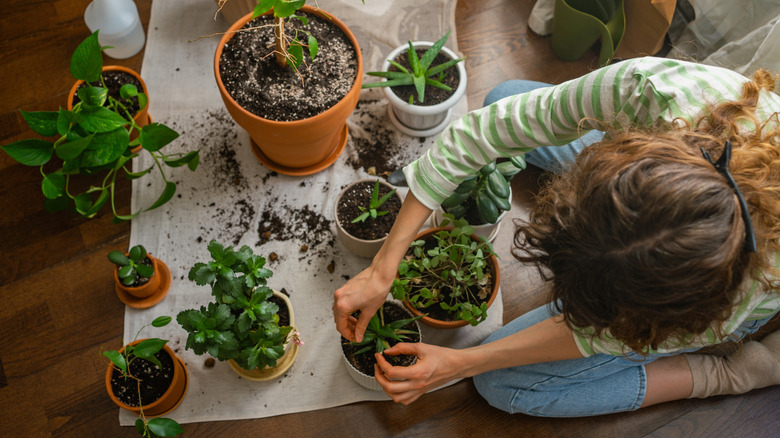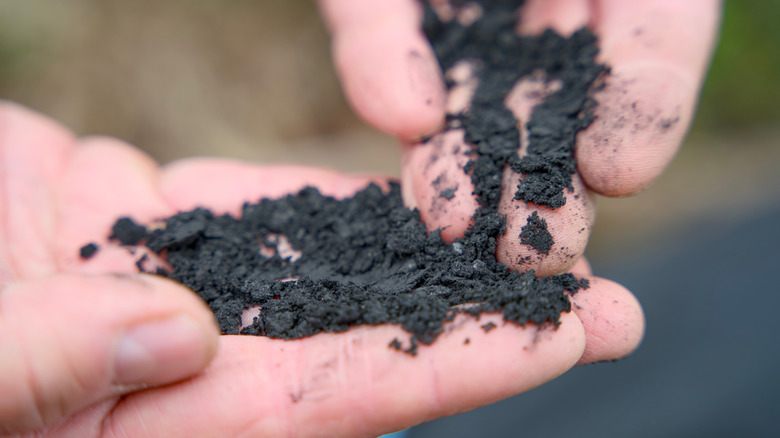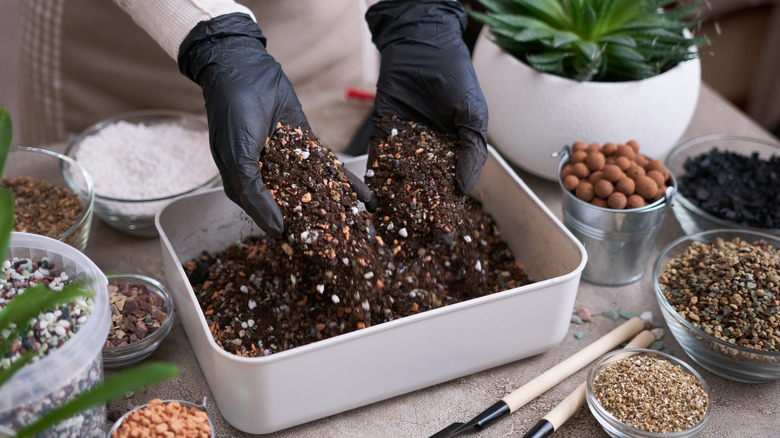The Unexpected Addition That Helps Keep Your Houseplants Strong & Healthy
We may receive a commission on purchases made from links.
You may have noticed charcoal is an ever-more popular ingredient, lending its cleansing power to skincare products, for instance, but it has a lesser-known use as a soil helper for indoor plants, leading to improved soil aeration and faster growth. While it might not be the first thing one would expect, adding activated charcoal, horticultural charcoal, or biochar to your houseplant's soil can increase plant health by giving your leafy friend better drainage, helping the plant access water and fertilizer, and stopping unwanted fungal growth and odors. Try out these properties by mixing a small amount right into the soil or adding some charcoal to the bottom of your plant pots, especially if you're growing tropical plants or incorporating a terrarium table into your home, which may not have another drainage element.
Despite the wonders charcoal can work, it's not a solution for all indoor plants. As an alkaline substance with a pH between 6.5 and 8.4, it isn't the best choice for plants that prefer acidic soil, like African violets. Give those indoor plants coffee grounds to help them thrive, instead. Also, don't simply use char or ashes left over from a barbecue on your precious houseplants, because there's a chance those can be made with harmful chemicals. Pick up some charcoal from your local gardening center, home improvement center, or order some online. Olivette Horticultural Biochar Activated Charcoal for Plants is one type to consider.
Choose the right charcoal for your houseplants
Charcoal is made by burning natural materials that contain carbon, but there are different ways to achieve that, resulting in various types of this soil amendment to choose from. Knowing the benefits and drawbacks of each kind can help you make the best choice for your plant pots or terrarium.
Indoor gardeners tend to use activated charcoal, horticultural charcoal, or biochar. Activated charcoal has been put under extreme heat, which expands its surface area, making it very absorbent. It's often made of coconut shells, wood, or other natural material that becomes very porous during the heating process. Horticultural charcoal hasn't undergone as intense a burning and is less porous than the activated kind. Biochar often starts out as agricultural waste and undergoes a heating process that turns it into a charcoal-like substance. The char itself isn't a replacement for fertilizer since it hasn't been shown to add many growth-spurring nutrients, but it does help the soil use fertilizer more effectively.
If you want extra help repelling common pests that'll wreak havoc on your houseplants, activated charcoal is a good choice. You can sprinkle some on the surface of the soil in addition to its function of providing drainage and water absorption on the bottom of a pot. But be careful — this type of charcoal can absorb nutrients from the soil, so you'll want to be more generous with your fertilizer. Horticultural charcoal is alkaline enough to stay in the sweet spot of what most houseplants need, but adding too much into an already alkaline soil mix can make the pH too high, so use it judiciously. Biochar sits between activated and horticultural charcoal in terms of porosity. It's ideal for low-maintenance gardening, since it doesn't tend to need frequent replacement.
How to add charcoal to potted plants
Once you've chosen a type of charcoal, try adding it to the soil or the bottom of the container of plants that benefit from extra drainage. It's a welcome addition for plants that live in glass jars or terraria, because unlike other pots, they don't have a built-in drainage hole. A handful of charcoal can act as an antifungal agent and sop up extra water to help prevent the plant from developing root rot. You can also mix charcoal into a potting mix to create the best soil for a thriving monstera or another plant that needs airy soil conditions. If you're using biochar, it's possible to use it as a substitute for a potting mix. In other cases, you can add it into a mix in place of ingredients that typically help drainage, such as perlite and wood chips.
The amount of charcoal to use will vary depending on the container and how much soil is used. In a terrarium, spread a 1/2 inch layer of charcoal above rocks or anything else that's used for drainage. Making your own potting mix will typically involve one part charcoal to three parts each coco coir, bark, and perlite.
The common link in these cases is that charcoal helps achieve the needed balance of air and water in soil, due to the way it opens up the soil's structure while still providing density from its organic matter. Biochar, in particular, changes the surface area of soil so it's easier for plants to retain the nutrients they need to grow healthy and strong. Finally, soil with charcoal in it may be hospitable to microbes that aid a plant's ability to absorb the water it needs and can help a plant fend off diseases.


